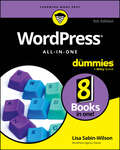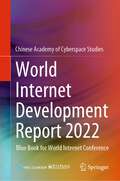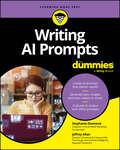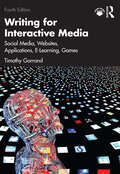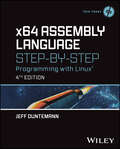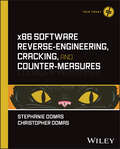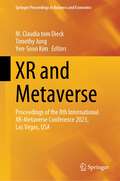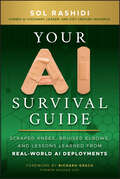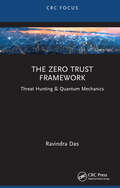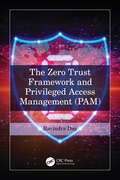- Table View
- List View
WordPress All-in-One For Dummies
by Lisa Sabin-WilsonThe no-nonsense guide to building your own WordPress site With the help of WordPress All-in-One For Dummies, you can get your first WordPress blog or website set up in no time. Fully updated for the latest WordPress releases, this 8-books-in-1 guide walks you through all the features of this powerful web builder. You’ll discover how to choose and customize a theme, pick the perfect web host and URL, and manage multiple websites with multiple authors. Use WordPress as a content management software (CMS) platform, work with multimedia formats, and add plugins to your site. With state-of-the-art features, WordPress has become the go-to platform for website owners and bloggers who want to be noticed. This beginner-friendly Dummies guide gives you the know-how to make WordPress work for you. Build a website or blog with WordPress, the leading open-source web builder Discover the powerful, customizable features of the latest versions of WordPress Allow multiple people to contribute to your site and keep your content organized Easily make changes and modifications with the WordPress interface Both WordPress novices and more experienced users looking to dive into new features will love the easy-to-follow instructions and tips in WordPress All-in-One For Dummies.
WordPress All-in-One For Dummies
by Lisa Sabin-WilsonThe no-nonsense guide to building your own WordPress site With the help of WordPress All-in-One For Dummies, you can get your first WordPress blog or website set up in no time. Fully updated for the latest WordPress releases, this 8-books-in-1 guide walks you through all the features of this powerful web builder. You’ll discover how to choose and customize a theme, pick the perfect web host and URL, and manage multiple websites with multiple authors. Use WordPress as a content management software (CMS) platform, work with multimedia formats, and add plugins to your site. With state-of-the-art features, WordPress has become the go-to platform for website owners and bloggers who want to be noticed. This beginner-friendly Dummies guide gives you the know-how to make WordPress work for you. Build a website or blog with WordPress, the leading open-source web builder Discover the powerful, customizable features of the latest versions of WordPress Allow multiple people to contribute to your site and keep your content organized Easily make changes and modifications with the WordPress interface Both WordPress novices and more experienced users looking to dive into new features will love the easy-to-follow instructions and tips in WordPress All-in-One For Dummies.
World Internet Development Report 2022: Blue Book for World Internet Conference
by Publishing House of Electronics IndustryThis book objectively presents the status quo and trends of world Internet development in 2022, systematically summarises Internet development in major countries and regions, and deeply analyses new development conditions and trends in key areas of the Internet in terms of eight aspects, i.e. information infrastructure, information technology, digital economy, e-government, cybermedia, cybersecurity, cyberlaw and international cyberspace governance. This book maintains the index system of world Internet development, optimises some indexes, and comprehensively evaluates Internet development in major countries and regions of the world, in order to better show the strength and characteristics of Internet development in various countries and reflect the overall trend of world Internet development in a comprehensive, accurate and objective way.This book collects the latest research results on the world Internet development. With diverse topics and in-depth discussions, this book is of great significance to those involved in the Internet field in government departments, Internet companies, scientific research institutions and universities who hope to fully understand the world's Internet development.
World Yearbook of Education 2024: Digitalisation of Education in the Era of Algorithms, Automation and Artificial Intelligence (World Yearbook of Education)
by Ben Williamson Janja Komljenovic Kalervo N. GulsonProviding a comprehensive, global overview of the digitalisation of education, the World Yearbook of Education 2024 examines the ways advanced digital technologies are transforming educational practices, institutions and policy processes.Establishing a critical research agenda for analysing the digitalisation of education, the carefully selected chapters in this collection interrogate the current impacts of new digital technologies, emerging controversies over emerging data practices and future implications of algorithmic systems, automated decision-making and AI in education. Organised into four sections, the contributions in the collection examine the following: The historical, scientific and technical foundations of contemporary digitalisation in education The political and economic dynamics that underpin the education technology industry and new platform models of education How algorithms, automation and AI support new modes of data-driven governance and control of education systems Controversies over the inequitable effects of digitalisation in education, and proposals for data justice, ethics and regulation This resource is ideal reading for researchers, students, educational practitioners and policy officials interested in understanding the future of digital technologies in education.
World Yearbook of Education 2024: Digitalisation of Education in the Era of Algorithms, Automation and Artificial Intelligence (World Yearbook of Education)
Providing a comprehensive, global overview of the digitalisation of education, the World Yearbook of Education 2024 examines the ways advanced digital technologies are transforming educational practices, institutions and policy processes.Establishing a critical research agenda for analysing the digitalisation of education, the carefully selected chapters in this collection interrogate the current impacts of new digital technologies, emerging controversies over emerging data practices and future implications of algorithmic systems, automated decision-making and AI in education. Organised into four sections, the contributions in the collection examine the following: The historical, scientific and technical foundations of contemporary digitalisation in education The political and economic dynamics that underpin the education technology industry and new platform models of education How algorithms, automation and AI support new modes of data-driven governance and control of education systems Controversies over the inequitable effects of digitalisation in education, and proposals for data justice, ethics and regulation This resource is ideal reading for researchers, students, educational practitioners and policy officials interested in understanding the future of digital technologies in education.
Writing AI Prompts For Dummies
by Stephanie Diamond Jeffrey AllanLearn the art of writing effective AI prompts and break into an exciting new career field Writing AI Prompts For Dummies gets you started on the path toward becoming an “AI psychologist” capable of getting all types of output from AI systems. This book walks you through the process of mining great results from leading platforms, so you can save time, solve problems, explore creative ideas, conduct research, and beyond. Even if you’re brand new to using AI chatbots, you’ll be able to follow the jargon-free explanations and instructions inside to learn how to ask questions and make requests in terms any AI can understand. Then, you can convert your new skill into greater productivity in your life, or even into a new career. Prompt engineering is a fast-growing career opportunity with six-figure salaries attached. Who knows? This Dummies guide could be your launchpad to a future as an AI whisperer. Explore the top AI chatbots, creativity engines, and productivity tools Learn how to write basic text prompts that generate concise, effective output Create AI-generated photos and illustrations that match your vision Save time writing code, designing websites, or conducting research When asked “Who needs to learn prompt engineering?” ChatGPT clarifies: professionals, creatives, educators, scientists, and entrepreneurs in many fields can benefit an enhanced ability to use AI productively. And for anyone working in AI, natural language processing, or related areas, Writing AI Prompts For Dummies is simply a must.
Writing AI Prompts For Dummies
by Stephanie Diamond Jeffrey AllanLearn the art of writing effective AI prompts and break into an exciting new career field Unlock the full power of generative AI with Writing AI Prompts For Dummies, a comprehensive guide that will teach you how to confidentially write effective AI prompts. Whether it's text, images, or even videos and music you're aiming to create, this book provides the foundational knowledge and practical strategies needed to produce impressive results. Embark on a journey of discovery with Writing AI Prompts For Dummies and learn how to: Craft AI prompts that produce the most powerful results. Navigate the complexities of different AI platforms with ease. Generate a diverse range of content, from compelling narratives to stunning visuals. Refine AI-generated output to perfection and integrate that output effectively into your business or project. This resource is brimming with expert guidance and will help you write AI prompts that achieve your objectives. Whether you're a marketer, educator, artist, or entrepreneur, Writing AI Prompts For Dummies is your indispensable guide for leveraging AI to its fullest potential. Get ready to harness the power of artificial intelligence and spark a revolution in your creative and professional efforts.
Writing for Interactive Media: Social Media, Websites, Applications, e-Learning, Games
by Timothy GarrandThis thoroughly revised fourth edition teaches students and professionals how to create interactive content for all types of new media and become successful writers or designers in a variety of fields.This comprehensive guide is grounded in the core principles and skills of interactive media writing, in which writers create text and structure content to guide users through interactive products such as websites or software. The book examines case studies on interactive formats including complex informational websites, computer games, e-learning courses, training programs, and immersive exhibits. These case studies assess real-world products and documentation used by professional writers such as scripts, outlines, screenshots, and flowcharts. The book also provides practical advice on how to use interactive media writing skills to advance careers in the social media, technical, instructional communication, and creative media fields. This edition includes new chapters on UX Writing and Content Design, Social Media Writing, and Writing for Mobile.Writing for Interactive Media prepares students for the writing challenges of today’s technology and media. It can be used as a core textbook for courses in UX Writing, Writing for Digital Media, and Technical and Professional Communication and is a valuable resource for writing professionals at all levels.Supplemental resources include a sample syllabus, class assignments, student exercises, scripts, outlines, flowcharts, and other interactive writing samples. They are available online at www.routledge.com/9781032554242
Writing for Interactive Media: Social Media, Websites, Applications, e-Learning, Games
by Timothy GarrandThis thoroughly revised fourth edition teaches students and professionals how to create interactive content for all types of new media and become successful writers or designers in a variety of fields.This comprehensive guide is grounded in the core principles and skills of interactive media writing, in which writers create text and structure content to guide users through interactive products such as websites or software. The book examines case studies on interactive formats including complex informational websites, computer games, e-learning courses, training programs, and immersive exhibits. These case studies assess real-world products and documentation used by professional writers such as scripts, outlines, screenshots, and flowcharts. The book also provides practical advice on how to use interactive media writing skills to advance careers in the social media, technical, instructional communication, and creative media fields. This edition includes new chapters on UX Writing and Content Design, Social Media Writing, and Writing for Mobile.Writing for Interactive Media prepares students for the writing challenges of today’s technology and media. It can be used as a core textbook for courses in UX Writing, Writing for Digital Media, and Technical and Professional Communication and is a valuable resource for writing professionals at all levels.Supplemental resources include a sample syllabus, class assignments, student exercises, scripts, outlines, flowcharts, and other interactive writing samples. They are available online at www.routledge.com/9781032554242
Writing In-House Medical Device Software in Compliance with EU, UK, and US Regulations
by Philip S. Cosgriff Matthew J. MemmottThis book is a comprehensive guide to producing medical software for routine clinical use. It is a practical guidebook for medical professionals developing software to ensure compliance with medical device regulations for software products intended to be sold commercially, shared with healthcare colleagues in other hospitals, or simply used in-house.It compares requirements and latest regulations in different global territories, including the most recent EU regulations as well as UK and US regulations.This book is a valuable resource for practising clinical scientists producing medical software in-house, in addition to other medical staff writing small apps for clinical use, clinical scientist trainees, and software engineers considering a move into healthcare. The academic level is post-graduate, as readers will require a basic knowledge of software engineering principles and practice.Key Features: Up to date with the latest regulations in the UK, the EU, and the US Useful for those producing medical software for routine clinical use Contains best practice
Writing In-House Medical Device Software in Compliance with EU, UK, and US Regulations
by Philip S. Cosgriff Matthew J. MemmottThis book is a comprehensive guide to producing medical software for routine clinical use. It is a practical guidebook for medical professionals developing software to ensure compliance with medical device regulations for software products intended to be sold commercially, shared with healthcare colleagues in other hospitals, or simply used in-house.It compares requirements and latest regulations in different global territories, including the most recent EU regulations as well as UK and US regulations.This book is a valuable resource for practising clinical scientists producing medical software in-house, in addition to other medical staff writing small apps for clinical use, clinical scientist trainees, and software engineers considering a move into healthcare. The academic level is post-graduate, as readers will require a basic knowledge of software engineering principles and practice.Key Features: Up to date with the latest regulations in the UK, the EU, and the US Useful for those producing medical software for routine clinical use Contains best practice
x64 Assembly Language Step-by-Step: Programming with Linux (Tech Today)
by Jeff DuntemannThe long-awaited x64 edition of the bestselling introduction to Intel assembly language In the newly revised fourth edition of x64 Assembly Language Step-by-Step: Programming with Linux, author Jeff Duntemann delivers an extensively rewritten introduction to assembly language with a strong focus on 64-bit long-mode Linux assembler. The book offers a lighthearted, robust, and accessible approach to a challenging technical discipline, giving you a step-by-step path to learning assembly code that’s engaging and easy to read. x64 Assembly Language Step-by-Step makes quick work of programmable computing basics, the concepts of binary and hexadecimal number systems, the Intel x86/x64 computer architecture, and the process of Linux software development to dive deep into the x64 instruction set, memory addressing, procedures, macros, and interface to the C-language code libraries on which Linux is built. You’ll also find: A set of free and open-source development and debugging tools you can download and put to use immediately Numerous examples woven throughout the book to illustrate the practical implementation of the ideas discussed within Practical tips on software design, coding, testing, and debuggingA one-stop resource for aspiring and practicing Intel assembly programmers, the latest edition of this celebrated text provides readers with an authoritative tutorial approach to x64 technology that’s ideal for self-paced instruction.
x64 Assembly Language Step-by-Step: Programming with Linux (Tech Today)
by Jeff DuntemannThe long-awaited x64 edition of the bestselling introduction to Intel assembly language In the newly revised fourth edition of x64 Assembly Language Step-by-Step: Programming with Linux, author Jeff Duntemann delivers an extensively rewritten introduction to assembly language with a strong focus on 64-bit long-mode Linux assembler. The book offers a lighthearted, robust, and accessible approach to a challenging technical discipline, giving you a step-by-step path to learning assembly code that’s engaging and easy to read. x64 Assembly Language Step-by-Step makes quick work of programmable computing basics, the concepts of binary and hexadecimal number systems, the Intel x86/x64 computer architecture, and the process of Linux software development to dive deep into the x64 instruction set, memory addressing, procedures, macros, and interface to the C-language code libraries on which Linux is built. You’ll also find: A set of free and open-source development and debugging tools you can download and put to use immediately Numerous examples woven throughout the book to illustrate the practical implementation of the ideas discussed within Practical tips on software design, coding, testing, and debuggingA one-stop resource for aspiring and practicing Intel assembly programmers, the latest edition of this celebrated text provides readers with an authoritative tutorial approach to x64 technology that’s ideal for self-paced instruction.
x86 Software Reverse-Engineering, Cracking, and Counter-Measures (Tech Today)
by Stephanie Domas Christopher DomasA crystal-clear and practical blueprint to software disassembly x86 Software Reverse-Engineering, Cracking, and Counter-Measures is centered around the world of disassembling software. It will start with the basics of the x86 assembly language, and progress to how that knowledge empowers you to reverse-engineer and circumvent software protections. No knowledge of assembly, reverse engineering, or software cracking is required. The book begins with a bootcamp on x86, learning how to read, write, and build in the assembly that powers a massive amount of the world’s computers. Then the book will shift to reverse engineering applications using a handful of industry favorites such as IDA, Ghidra, Olly, and more. Next, we move to cracking with techniques such as patching and key generation, all harnessing the power of assembly and reverse engineering. Lastly, we’ll examine cracking from a defensive perspective. Providing learners with techniques to be a better defender of their own software, or knowledge to crack these techniques more effectively. Assembly: computer Architecture, x86, system calls, building and linking, ASCII, condition codes, GDB, control flow, stack, calling conventions Reverse Engineering: reconnaissance, strings, RE strategy, stripping, linking, optimizations, compilers, industry tools Cracking: patching, key checkers, key generators, resource hacking, dependency walking Defense: anti-debugging, anti-tamper, packing, cryptors/decryptors, whitelist, blacklist, RASP, code signing, obfuscationA practical and hands-on resource for security professionals to hobbyists, this book is for anyone who wants to learn to take apart, understand, and modify black-box software. x86 Software Reverse-Engineering, Cracking, and Counter-Measures is a vital resource for security researchers, reverse engineers and defenders who analyze, research, crack or defend software applications.
x86 Software Reverse-Engineering, Cracking, and Counter-Measures (Tech Today)
by Stephanie Domas Christopher DomasA crystal-clear and practical blueprint to software disassembly x86 Software Reverse-Engineering, Cracking, and Counter-Measures is centered around the world of disassembling software. It will start with the basics of the x86 assembly language, and progress to how that knowledge empowers you to reverse-engineer and circumvent software protections. No knowledge of assembly, reverse engineering, or software cracking is required. The book begins with a bootcamp on x86, learning how to read, write, and build in the assembly that powers a massive amount of the world’s computers. Then the book will shift to reverse engineering applications using a handful of industry favorites such as IDA, Ghidra, Olly, and more. Next, we move to cracking with techniques such as patching and key generation, all harnessing the power of assembly and reverse engineering. Lastly, we’ll examine cracking from a defensive perspective. Providing learners with techniques to be a better defender of their own software, or knowledge to crack these techniques more effectively. Assembly: computer Architecture, x86, system calls, building and linking, ASCII, condition codes, GDB, control flow, stack, calling conventions Reverse Engineering: reconnaissance, strings, RE strategy, stripping, linking, optimizations, compilers, industry tools Cracking: patching, key checkers, key generators, resource hacking, dependency walking Defense: anti-debugging, anti-tamper, packing, cryptors/decryptors, whitelist, blacklist, RASP, code signing, obfuscationA practical and hands-on resource for security professionals to hobbyists, this book is for anyone who wants to learn to take apart, understand, and modify black-box software. x86 Software Reverse-Engineering, Cracking, and Counter-Measures is a vital resource for security researchers, reverse engineers and defenders who analyze, research, crack or defend software applications.
XR and Metaverse: Proceedings of the 8th International XR-Metaverse Conference 2023, Las Vegas, USA (Springer Proceedings in Business and Economics)
by M. Claudia tom Dieck Timothy Jung Yen-Soon KimThis book offers a comprehensive collection of the latest research presented at the 8th International XR-Metaverse Conference, held in Las Vegas, USA in 2023. Its goal is to bridge the gap between academia and industry by advancing the state of the art in metaverse, XR, AI-based AR and VR technologies, and by exploring their applications in various fields such as business, marketing, education, health care, tourism, events, fashion, entertainment, retail, and the gaming industry. Including contributions by prominent XR scholars from around the globe, the book addresses a wide range of significant topics concerning XR and the metaverse. Showcasing cutting-edge research outputs, it will be of interest to both academics and practitioners eager to catch up on the latest developments in this rapidly evolving field.
Your AI Survival Guide: Scraped Knees, Bruised Elbows, and Lessons Learned from Real-World AI Deployments
by Sol RashidiPractical and proven AI deployment strategies for non-technical business leaders In Your AI Survival Guide: Scraped Knees, Bruised Elbows, and Lessons Learned from Real-World AI Deployments, business executive and technologist Sol Rashidi delivers an insightful and practical discussion of how to deploy artificial intelligence in your company. Having helped IBM launch Watson in 2011, Sol has first-hand knowledge of the ups, downs, and change management intricacies that can help you with a successful deployment beyond all the AI hype. She walks you through various frameworks for how to establish your AI strategy, pick your use cases, prepare your non-technology teams, and overcome the most common obstacles standing in the way of successfully implementing AI in your business, based on her many years of deploying AI projects in businesses, which few can claim. Sol demystifies the topic of artificial intelligence in a way that business leaders and business owners—and those who want to be more business minded—can easily understand. The book also offers: Real-world use cases from ten different industries, including retail, healthcare, energy, insurance, agriculture, and more; ten different functions, including supply chain, manufacturing, procurement, legal, and more; and personal stories, anecdotes, and insights gained from implementations Techniques for facilitating executive-level buy-in for your most ambitious and promising AI strategies Jargon-free and accessible language that simplifies a seemingly complicated topic And practical advice that’s not based on AI hype Perfect for executives, managers, directors, founders, entrepreneurs, practitioners and other non-technical business leaders, Your AI Survival Guide is the ideal guide to help you deploy artificial intelligence in your business and increase your chances of success whether your business goal is top-line growth, increased productivity, or efficiency gains without having to add headcount as the go-to answer.
Your AI Survival Guide: Scraped Knees, Bruised Elbows, and Lessons Learned from Real-World AI Deployments
by Sol RashidiPractical and proven AI deployment strategies for non-technical business leaders In Your AI Survival Guide: Scraped Knees, Bruised Elbows, and Lessons Learned from Real-World AI Deployments, business executive and technologist Sol Rashidi delivers an insightful and practical discussion of how to deploy artificial intelligence in your company. Having helped IBM launch Watson in 2011, Sol has first-hand knowledge of the ups, downs, and change management intricacies that can help you with a successful deployment beyond all the AI hype. She walks you through various frameworks for how to establish your AI strategy, pick your use cases, prepare your non-technology teams, and overcome the most common obstacles standing in the way of successfully implementing AI in your business, based on her many years of deploying AI projects in businesses, which few can claim. Sol demystifies the topic of artificial intelligence in a way that business leaders and business owners—and those who want to be more business minded—can easily understand. The book also offers: Real-world use cases from ten different industries, including retail, healthcare, energy, insurance, agriculture, and more; ten different functions, including supply chain, manufacturing, procurement, legal, and more; and personal stories, anecdotes, and insights gained from implementations Techniques for facilitating executive-level buy-in for your most ambitious and promising AI strategies Jargon-free and accessible language that simplifies a seemingly complicated topic And practical advice that’s not based on AI hype Perfect for executives, managers, directors, founders, entrepreneurs, practitioners and other non-technical business leaders, Your AI Survival Guide is the ideal guide to help you deploy artificial intelligence in your business and increase your chances of success whether your business goal is top-line growth, increased productivity, or efficiency gains without having to add headcount as the go-to answer.
YSEC Yearbook of Socio-Economic Constitutions 2023: Law and the Governance of Artificial Intelligence (YSEC Yearbook of Socio-Economic Constitutions #2023)
by Eduardo Gill-Pedro Andreas MobergArtificial intelligence (AI) has the potential to radically transform our society. It may lead to a massive increase in the capabilities of humankind and allow us to address some of our most intractable challenges. It may also entail profound disruption to structures and processes that have sustained our society over centuries. These developments present a unique challenge to the socio-economic constitutional arrangements which govern our world at national, regional and international level. The deployment of increasingly powerful AI systems, able to function with increasing degree of autonomy, has led to concerns over loss of human control of important societal processes, over the disruption of existing economic, social and legal relationships, and over the empowerment of some societal actors at the expense of others, together with the entrenchment of situations of domination or discrimination. It has also made increasingly clear how tremendous the potential benefits, that these technologies may bring, are to those who successfully develop and deploy them. There is therefore great pressure on governments, international institutions, public authorities, civil society organisations, industry bodies and individual firms to introduce or adapt mechanisms and structures that will avoid the potentially negative outcomes of AI and achieve the positive ones. These mechanisms and structures, which have been given the umbrella term ‘AI governance’, cover a wide range of approaches, from individual firms introducing ethical principles which they volunteer to abide by, to the European Union legislating an AI Act, which will prohibit certain types of AI applications and impose binding obligations on AI developers and deployers. The fast pace of innovation in the development of AI technologies is mirrored by the fast pace of development of the emerging field of AI governance, where traditional legislation by public bodies is complemented with more innovative approaches, such ashybrid and adaptive governance, ethical alignment, governance by design and the creation of regulatory sandboxes. The chapter “AI and Sensitive Personal Data Under the Law Enforcement Directive: Between Operational Efficiency and Legal Necessity” is available open access under a Creative Commons Attribution 4.0 International License via link.springer.com.
The Zero Trust Framework: Threat Hunting & Quantum Mechanics
by Ravindra DasThe Cybersecurity landscape is a daunting one today. It is nothing like it was 10 years ago. Now, it has become very complex, covert, dynamic, and stealthy. It has literally become a cat and mouse game, in which the Cyberattacker is still one step ahead. This is despite all of the technology that is available to us a society, which includes Artificial Intelligence (AI) and Machine Learning. Part of the other problem is that human beings are resistant to change. For example, the password is still the favored way of authenticating and authorizing an individual, but it too has shown its grave limitations. Despite the use of Password Managers, which can create long and complex passwords, people still resort to their old fashioned ways of doing things. So what is needed now is an extreme change, in which, unfortunately, people have no choice in whether or not they will participate. It is called the Zero Trust Framework, and in this methodology, absolutely nobody can be trusted in either the internal or the external environments. The mantra here is to keep verifying everybody, all the time. The Zero Trust Framework also involves the concept of segmentation, in which the IT and Network Infrastructure of a business is broken down into smaller components, much like a Subnet. Each component will have its own layer of security, and every individual must be authenticated via the use of Multifactor Authentication (MFA). In this book, we review both the concepts and mechanics behind the Zero Trust Framework. We also introduce advanced technologies into it, including the use of Biometrics, the Public Key Infrastructure, and Quantum Mechanics/Quantum Cryptography.
The Zero Trust Framework: Threat Hunting & Quantum Mechanics
by Ravindra DasThe Cybersecurity landscape is a daunting one today. It is nothing like it was 10 years ago. Now, it has become very complex, covert, dynamic, and stealthy. It has literally become a cat and mouse game, in which the Cyberattacker is still one step ahead. This is despite all of the technology that is available to us a society, which includes Artificial Intelligence (AI) and Machine Learning. Part of the other problem is that human beings are resistant to change. For example, the password is still the favored way of authenticating and authorizing an individual, but it too has shown its grave limitations. Despite the use of Password Managers, which can create long and complex passwords, people still resort to their old fashioned ways of doing things. So what is needed now is an extreme change, in which, unfortunately, people have no choice in whether or not they will participate. It is called the Zero Trust Framework, and in this methodology, absolutely nobody can be trusted in either the internal or the external environments. The mantra here is to keep verifying everybody, all the time. The Zero Trust Framework also involves the concept of segmentation, in which the IT and Network Infrastructure of a business is broken down into smaller components, much like a Subnet. Each component will have its own layer of security, and every individual must be authenticated via the use of Multifactor Authentication (MFA). In this book, we review both the concepts and mechanics behind the Zero Trust Framework. We also introduce advanced technologies into it, including the use of Biometrics, the Public Key Infrastructure, and Quantum Mechanics/Quantum Cryptography.
The Zero Trust Framework and Privileged Access Management (PAM)
by Ravindra DasThis book is about the Zero Trust Framework. Essentially, this is a methodology where the IT/Network Infrastructure of a business is segmented into smaller islands, each having its own lines of defense. This is primarily achieved through the use of Multifactor Authentication (MFA), where at least three more authentication layers are used, preferably being different from one another.Another key aspect of the Zero Trust Framework is known as Privileged Access Management (PAM). This is an area of Cybersecurity where the protection of superuser accounts, rights, and privileges must be protected at all costs from Cyberattackers. In this regard, this is where the Zero Trust Framework and PAM intertwine, especially in a Cloud-based platform, such as Microsoft Azure.However, as it has been reviewed in one of our previous books, the use of passwords is now becoming a nemesis, not only for individuals but for businesses as well. It is hoped that by combining the Zero Trust Framework with PAM, password use can be eradicated altogether, thus giving rise to a passwordless society.
The Zero Trust Framework and Privileged Access Management (PAM)
by Ravindra DasThis book is about the Zero Trust Framework. Essentially, this is a methodology where the IT/Network Infrastructure of a business is segmented into smaller islands, each having its own lines of defense. This is primarily achieved through the use of Multifactor Authentication (MFA), where at least three more authentication layers are used, preferably being different from one another.Another key aspect of the Zero Trust Framework is known as Privileged Access Management (PAM). This is an area of Cybersecurity where the protection of superuser accounts, rights, and privileges must be protected at all costs from Cyberattackers. In this regard, this is where the Zero Trust Framework and PAM intertwine, especially in a Cloud-based platform, such as Microsoft Azure.However, as it has been reviewed in one of our previous books, the use of passwords is now becoming a nemesis, not only for individuals but for businesses as well. It is hoped that by combining the Zero Trust Framework with PAM, password use can be eradicated altogether, thus giving rise to a passwordless society.
Mastering MongoDB 7.0: Achieve data excellence by unlocking the full potential of MongoDB
by Marko Aleksendrić Arek Borucki Leandro Domingues Malak Abu Hammad Elie Hannouch Rajesh Nair Rachelle PalmerGain MongoDB expertise and discover advanced queries and Atlas insights with this ultimate guide to version 7.0Key FeaturesEnhance your proficiency in advanced queries, aggregation, and optimized indexing to achieve peak MongoDB performanceMonitor, back up, and integrate applications effortlessly with MongoDB AtlasImplement security thorough RBAC, auditing, and encryption to ensure comprehensive data protection and privacyPurchase of the print or Kindle book includes a free PDF eBookBook DescriptionMastering MongoDB 7.0 explores the latest version of MongoDB, an exceptional NoSQL database solution that aligns with the needs of modern web applications. This book starts with an informative overview of MongoDB’s architecture and developer tools, guiding you through the process of connecting to databases seamlessly. This MongoDB book explores advanced queries in detail, including aggregation pipelines and multi-document ACID transactions. It delves into the capabilities of the MongoDB Atlas developer data platform and the latest features, such as Atlas Vector Search, and their role in AI applications, enabling developers to build applications with the scalability and performance that today’s organizations need. It also covers the creation of resilient search functionality using MongoDB Atlas Search. Mastering MongoDB 7.0’s deep coverage of advanced techniques encompasses everything from role-based access control (RBAC) to user management, auditing practices, and encryption across data, network, and storage layers. By the end of this book, you’ll have developed the skills necessary to create efficient, secure, and high-performing applications using MongoDB. You’ll have the confidence to undertake complex queries, integrate robust applications, and ensure data security to overcome modern data challenges.What you will learnExecute advanced MongoDB queries for intricate data insightsHarness the power of aggregation pipelines to transform dataEnsure data integrity with multi-document ACID transactionsOptimize query performance using strategic indexing techniquesNavigate MongoDB Atlas seamlessly for monitoring and backupsEnable robust search functionality with Atlas SearchMaster RBAC, user management, and data encryption for securityImplement auditing practices for transparency and accountabilityWho this book is forThis book is for developers with an intermediate skill level who aim to become MongoDB experts. Working knowledge of MongoDB is recommended to gain the most from this guide. Ideal for database administrators, app developers, and software engineers, this book will assist you in developing advanced skills to conquer intricate data tasks.
Building Real-World Web Applications with Vue.js 3: Build a portfolio of Vue.js and TypeScript web applications to advance your career in web development
by Joran QuintenBecome a VueJS professional through practical projects like building a to-do list, weather app, recipe app, fitness tracker, quiz app, and moreKey FeaturesIncrease your prospects of securing employment as a web developerFamiliarize yourself with the Vue ecosystem and build more advanced applications by leveraging the fundamentalsProgress at your own pace and build a personal project using a modern tech stackPurchase of the print or Kindle book includes a free PDF eBookBook DescriptionIn the ever-evolving web development landscape, Vue.js stands out with its intuitive design and progressive framework, empowering developers to create interactive and dynamic web applications. This book will help you stay in the forefront of modern web technologies by mastering Vue.js through hands-on projects and practical applications. Building Real-World Web Applications with Vue.js 3 is your guide to exploring the core concepts of Vue.js, setting up your development environment, and creating your first Vue.js application. You’ll progress by building a recipe app using Vuetify, followed by leveraging data visualization to create a fitness tracker featuring dynamic dashboards using external databases and Vue-ChartJS. You'll then get to grips with multiplatform development with Quasar to deploy your app. As you develop an interactive quiz app, you’ll be introduced to server-side logic with Nuxt.js, WebSockets for real-time communication, and client-server differentiation. Additionally, you’ll study experimental object recognition using TensorFlow, leveraging machine learning and camera input, and conclude by creating a portfolio website with Nuxt and Storyblok. By the end of this book, you'll have the knowledge and confidence to create your own Vue.js applications and build a portfolio to showcase your Vue.js skills to potential employers.What you will learnMaster VueJS fundamentals and best practicesBuild real-world applications and create a portfolioUse VueRouter and manage state with PiniaImplement Vuetify for rapid UI developmentDevelop multiplatform apps with Quasar FrameworkCreate interactive quizzes using WebSocket connectionsApply TensorFlow for object recognitionBuild a portfolio website with Nuxt and Storyblok CMSWho this book is forThis book is for aspiring Vue.js developers eager to dive into practical projects. Whether you're just starting your Vue.js journey or have basic knowledge of JavaScript and web technologies, this book is a valuable resource, taking a hands-on approach to establishing a solid foundation in Vue.js while working on a variety of real-world projects.
